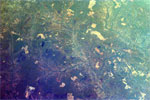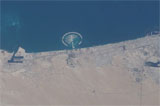
The Audubon Aquarium of the Americas in New Orleans apparently survived Hurricane Katrina relatively unscathed according to a report in The Baltimore Sun. Hurricane Katrina hit the Louisiana city Monday.
Illegal loggers will now face mandatory jail time in Malaysia under new laws expected to be implemented sometime early next year. Existing enforcement efforts, which rely on fines but are poorly enforced, have largely failed to curb illegal wood harvesting in the country's tropical rainforests.
August 30, 2005
A dramatic rise in carbon dioxide 250 million years ago may have caused global temperatures to soar and result in Earth's greatest mass extinction, according to a study published in the September issue of Geology. Global warming, which may have produced temperatures 10 to 30 degrees Celsius higher than today, would have had a significant impact both on oceans, where about 95% of lifeforms became extinct, and on land, where almost 75% of species died out.
August 29, 2005
Late last month an atmospheric scientist at Massachusetts Institute of Technology published a study in Nature that found that hurricanes have grown significantly more powerful and destructive over the past three decades. Kerry Emanuel, the author of the study, warns that since hurricanes depend on warm water to form and build, global climate change might increase the effect of hurricanes still further in coming years.
Experts say that Hurricane Katrina could produce an environmental disaster in New Orleans. Ivor van Heerden, director of the Louisiana State University Public Health Research Center in Baton Rouge, went so far as to warn "We need to recognize we may be about to experience our equivalent of the Asian tsunami, in terms of the damage and the numbers of people that can be killed."
August 28, 2005
I've added some special photo categories for images found on the site.
Madagascar has been called the great red island and from space, astronauts have remarked the island looks like it is bleeding to death. Soil conditions and poorly vegetated hillsides mean Madagascar loses more topsoil per hectare than any country in the world. Being one of the poorest nations on Earth, the people of Madagascar can ill afford this loss. In 2004 I set off to see one of the rivers that is carrying away the island's soils; the Manambolo of Western Madagascar
August 27, 2005

|
August 26, 2005
Between the 1967 and the 1990s, the Oriente rainforest of Ecuador suffered serious degradation and deforestation from Texaco's oil extraction and production activities. Today Texaco, now owned by Chevron, is facing a multi-billion dollar liability in a case stemming from its role in the environmental damage. Amazon Watch, an environmental group that has been tracking the case, says trial isn't going so well for the oil firm.
August 25, 2005
A group of scientists from Feati University in the Philippines recently devised a biological fuel cell that uses the enzyme Nicotinamide Adenine Dinucleotide (NAD) to directly convert biochemical energy into electricity. Their research raises the possibility that household pests like mosquitoes, rats, cockroaches and flies could be used as biofuel sources.
A proposal to create a refuge for African wildlife in North America has come under harsh criticism from African conservationists according to a report from Sapa-AFP.
A new report suggests that the Arctic ocean could have ice-free summers by 2100 as a result of global warming. melting is accelerating, and a team of researchers were unable to identify any natural processes that might slow the de-icing of the Arctic.
The New York Times reports that nine northeastern U.S. states are working on a plan to cap and then reduce the level of greenhouse gas emissions from power plants, the first U.S. deal of its kind and one which would see the region breaking with the Bush administration which refused to sign the Kyoto Protocol. The move raises interesting legal issues and comes as California, Washington and Oregon are considering a similar pact.
August 24, 2005

|
August 23, 2005
This week policy makers, industry leaders, and development experts are meeting in Abuja, Nigeria to discuss the future of African fisheries and aquaculture. The fisheries sector, consisting of both inland (freshwater) and marine fisheries, is a vital source of food and income to millions of Africans. Fish production, processing and trade provides employment for more than 10 million, while fish exports from Africa are worth US$ 2.7 billion annually. The following is a description of the summit from Fish for All, an initiative seeking to shape public policy on issues from issues as fish and development, fish and nutrition, health, livelihood, environment, gender, water, river basins and coasts, trade and economic growth.
August 22, 2005
At the upcoming 8th World Wilderness Congress in Anchorage, Alaska, Dr. Michael Fay, a world-renowned conservationist and explorer famous for his 15-month, 2,000 mile walk through Central Africa's forests, will offer the first report on his "MegaFlyover," the yearlong survey took him through close to 50 countries and covered 100,000 miles (160,000 kilometers). Over the course of his journey in a 1960's-era Cessna, Dr. Fay snapped digital photos every 20 seconds and landed in places rarely seen by humans. His survey will help set conservation priorities for the African continent.
August 20, 2005
Two hippo stories have been in the news lately. In the first, a baby hippopotamus that survived the tsunami waves on the Kenyan coast has formed a strong bond with a giant male century-old tortoise, in an animal facility in the port city of Mombassa, Kenya. In the second, an article by Mark Grossi in The Fresno Bee, hippo sweat could soon be used to prevent sunburn and protect skin from mosquito bites. Professor Christopher Viney at the University of California at Merced is working on deciphering the molecular structure of skin secretions from the hippopotamus. The research could eventually result in the creation of skin-care products based on compounds produced by the African animal.
August 19, 2005
A recent study by the Wildlife Conservation Society (WCS), the American Museum of Natural History (AMNH), and New York University, found that a single humpback whale migrated between the Atlantic and Indian oceans, the first documentation that whales move between ocean basins. It is believed that humpback whales make annual migrations of up to 25,000 km (16,000 miles).
August 18, 2005
Currently there are three "competitive" maps of the world's biodiversity hotspots based on different criteria: (1) areas rich in species diversity in general; (2) threatened species specifically; and (3) endemic species, which have a limited habitat. A new study found that these three maps share only 2.5% of their total area, thus adding confusion to what hotspots should be priorities for conservation efforts. The overlap all occurs in the Andean region of South America, implying that this area is the world's biodiversity champion.
August 17, 2005
Scientists in Australia are collecting blood from crocodiles in the hope of developing a powerful antibiotic for humans, after tests showed that the reptile's immune system kills the HIV virus.
August 16, 2005
An investigation by the International Fund for Animal Welfare found that wildlife products and live animals are trafficked illegally on the Internet.
August 12, 2005
I'm going to be away for a few days so I'm posting this a bit early.
A study in Ukraine found that Chernobyl's ecosystems seem to be recovering just 19 years after the region was badly contaminated with radiation from a nuclear meltdown. Researchers, who presented the finding at this week's Ecological Society of America meeting in Montreal, say that biodiversity is actually higher than before the disaster.
An article in New Scientist says the world's largest frozen peat bog is melting. A million square kilometers of bog across the western Siberia is turning into a mass of shallow lakes and potentially releasing massive amounts of methane, a potent greenhouse gas, into the atmosphere.
A related article from Reuters finds anecdotal evidence of animals behaving strangely and appearing in unusual areas possibly due to global climate change.
A report from Bloomberg says Brazil will increase the monitoring of logging in the Amazon rainforest and raise fines for those caught illegally clearing trees.
Machete-wielding poachers killed some 80 protected Olive Ridley sea turtles on Escobilla beach in Oaxaca, Mexico last weekend. The poachers were believed to be after turtle eggs, thought to be an aphrodisiac among locals. The discovery of the massacre was announced by Profepa, the government's environmental protection agency
Scientists at the Weizmann Institute of Science in Israel think they may have developed a green process for converting solar energy into hydrogen. Currently, most hydrogen is produced by processes that require the combustion of fossil fuels which produce polluting greenhouse gases.
August 11, 2005

|
August 10, 2005
German and Malagasy primatologists have discovered two new species of lemurs, naming one of them after Steve Goodman, a Field Museum scientist who has devoted nearly two decades to studying the animals of Madagascar.
August 9, 2005
Mark Hertsgaard argues in a San Francisco Chronicle editorial [external link] that nuclear energy isn't a viable option in the fight against global climate change and environmentalists should abandon it as a potential replacement for fossil fuel-based technologies. Citing a study by the Rocky Mountain Institute, Hertsgaard writes that "nuclear power is seven times less cost-effective at displacing carbon than the cheapest, fastest alternative -- energy efficiency." He uses the example of a $2 billion nuclear power plant. "If that $2 billion were instead spent to insulate drafty buildings, purchase hybrid cars or install super-efficient lightbulbs and clothes dryers, it would make unnecessary seven times more carbon consumption than the nuclear power plant would," writes Hertsgaard. "In short, energy efficiency offers a much bigger bang for the buck. In a world of limited capital, investing in nuclear power would divert money away from better responses to global warming, thus slowing the world's withdrawal from carbon fuels at a time when speed is essential."
August 8, 2005
The World Wildlife Fund (WWF), a leading conservation group, estimates that 1,000 orang-utans are poached annually from the wild, often for sale as pets for the wealthy. The organization says there are some 30,000 to 40,000 orang-utans left in the wild.
August 7, 2005
Chocolate contains a powerful stimulant, theobromine, that provides health benefits for humans but could prove fatal for your pet.
August 6, 2005
A large plantation owner was caught burning almost 2 million trees in the Amazon to make way for a cattle pastures. Workers for Jose Dias Pereira, a landholder in the Brazilian state of Para, were caught by Inspectors from the Brazilian Institute for the Environment and Renewable Natural Resources (IBAMA) and military police. IBAMA says this is the largest area of deforestation registered this year in Amazonia and has fined Pereira $770,000 (R$ 20.5 million reais).
August 5, 2005
In what has become almost an annual occurrence, fires are again burning in Indonesia and causing pollution troubles for neighboring Malaysia. Fires are set for agricultural land-clearing.
August 4, 2005
Authorities have found snakehead fish in New York state for the first time. Five snakeheads were captured in Meadow Lake in the New York borough of Queens during July and officials fear that the fish may be breeding. Snakeheads are of concern because they are voracious eaters that can rapidly ruin an ecosystem by consuming native species.
August 3, 2005

|
August 2, 2005
Today when Brazil is mentioned in the same sentence with "agriculture," people often first envision the Amazon rainforest giving way to soybean plantations and cattle farms. While the Amazon is being converted for such purposes, the cerrado, a vast area of savanna-like grasslands covering more than 20% of the country's surface area, is increasingly under threat as farmers from the United States and Europe are setting their sights on the biome's sizable agricultural potential.
August 1, 2005
In an effort to build its attractiveness as an ecotourism destination, Uganda has imported four rhinos from Kenya. The country hopes to develop a captive breeding program in an effort to reintroduce rhinos after their disappearance from the country in the 1960s due to poaching.